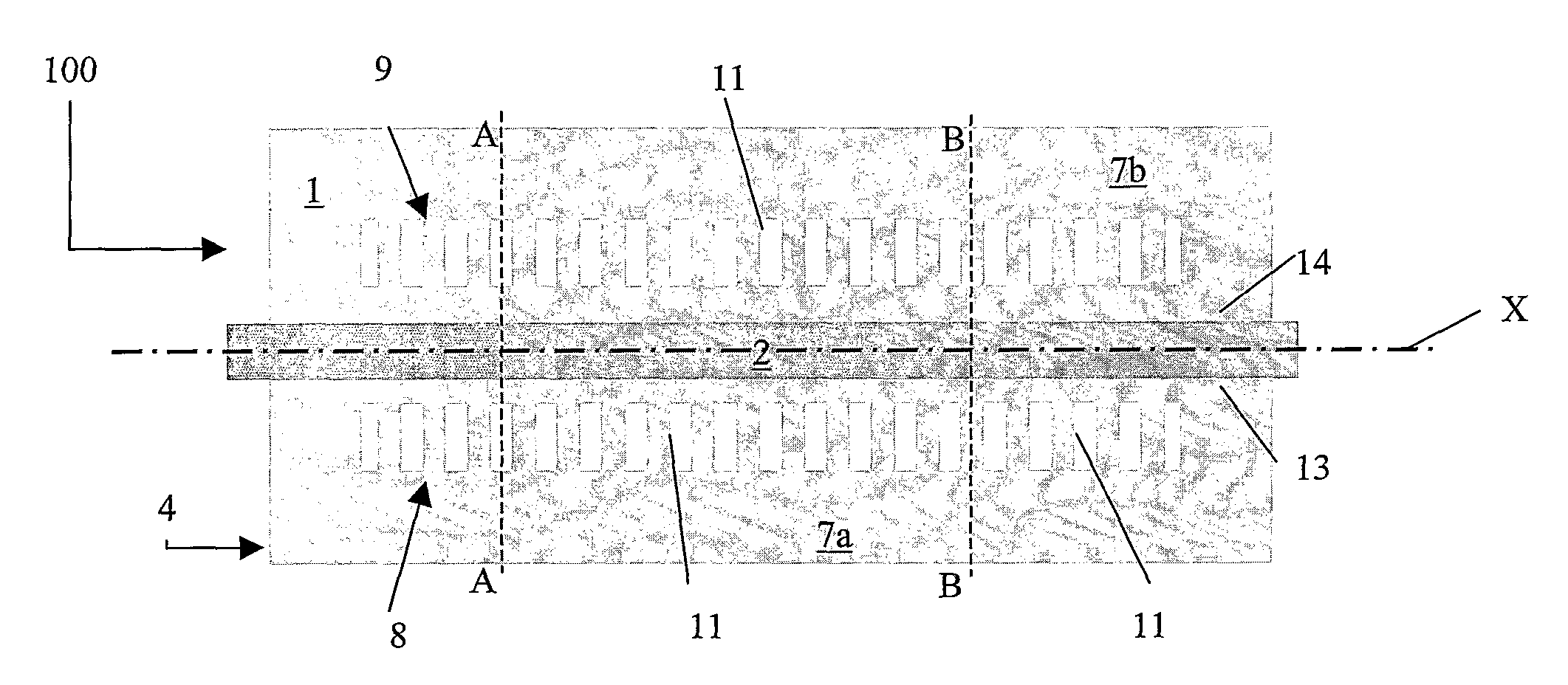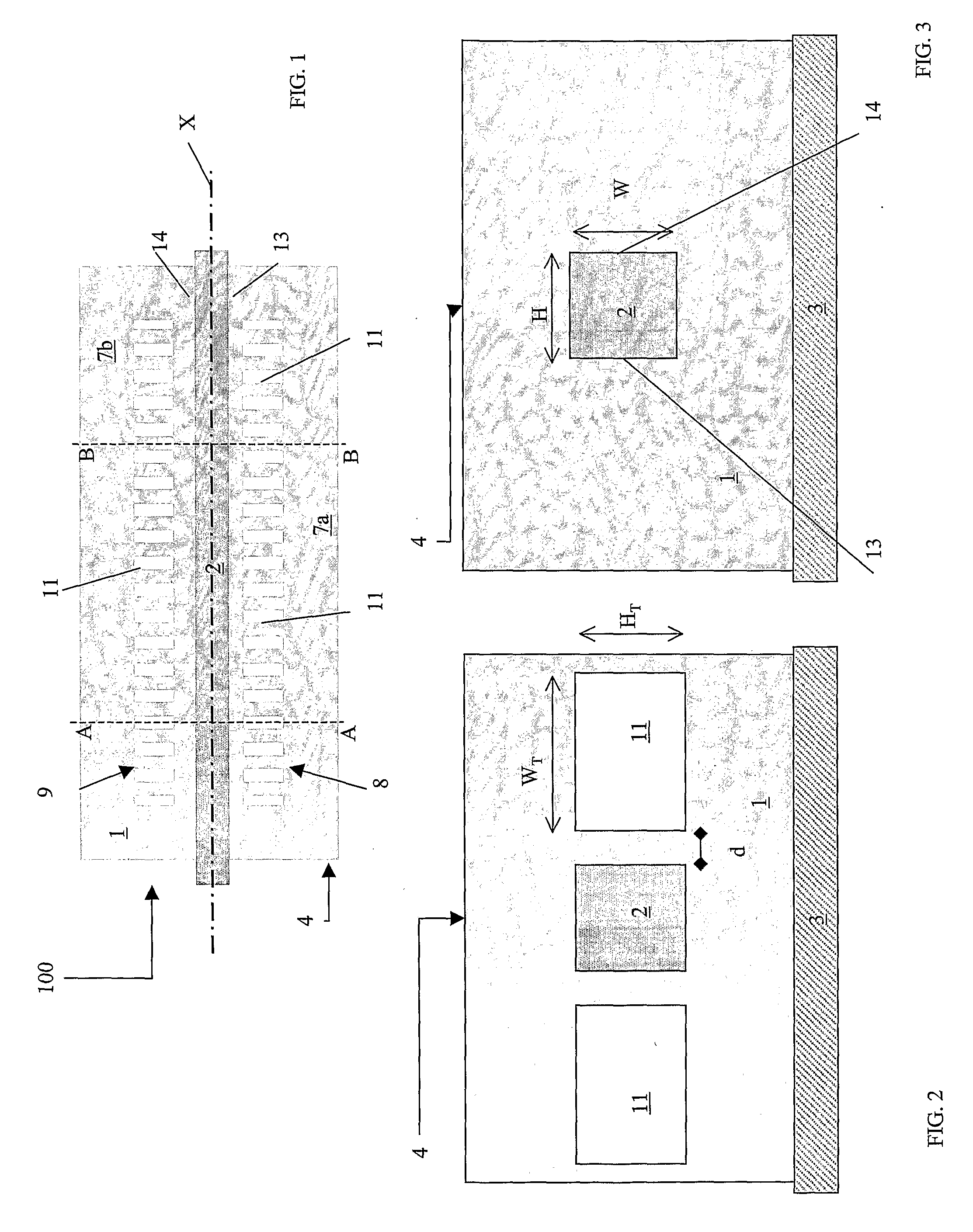Integrated wavelength selective grating-based filter
a wavelength selective filter and integrated technology, applied in the field of wavelength selective filters, can solve problems such as enlarging the overall dimension of devices, and achieve the effect of low coupling loss and simple connection between the integrated filter and the standard external fiber of the transmission system
- Summary
- Abstract
- Description
- Claims
- Application Information
AI Technical Summary
Benefits of technology
Problems solved by technology
Method used
Image
Examples
example 1
[0098] With reference to FIGS. 1-3 and 15, the lower cladding 5 is realized in SiO2 with a thickness of 10 μm and a refractive index of nlower=1.446, and it is deposited on a silicon wafer 3.
[0099] The core 2, having a 4.5×4.5 μm2 cross-section, is realized in Ge-doped SiO2 (ncore=1.456).
[0100] The lateral cladding 7 is realized in BPSG, having a refractive index of nlateral=1.446.
[0101] The upper cladding 6, having a thickness of 10 μm, is realized in SiO2.
[0102] The first and second plurality 8, 9 of grating trenches 11 forming the grating structure have a width WT of 3 μm and a height HT of 4.5 μm, and are filled with air (nair=1). Therefore the refractive index difference is ΔnG=0.446.
[0103] The distance of the trenches 11 from the core is d=500 nm. The grating period is equal to 536 nm with a duty cycle of 50%.
[0104] Considering an input signal applied to an input port 21 of the filtering element 100 comprising a plurality of channels having wavelengths spaced apart as de...
example 2
[0127] A filtering element 100 is realized following the process outlined below.
[0128] On top of a silicon wafer 3, a SiO2 layer (the lower cladding 5) is realized by thermal oxidation, having a thickness of 10 μm. On top of this layer, a core layer 2′ which is made of Ge-doped SiO2 and which has a thickness of 4.4 μm, is deposited using PECVD.
[0129] The core layer 2′ is thus covered by a polysilicon layer 12, 0.5 μm thick, deposited using LPCVD. The polysilicon layer 12 and the core layer 2′ are thus patterned using a dry etching technique.
[0130] The BPSG lateral cladding layer 7′ is then deposited by Atmospheric Pressure Chemical Vapour Deposition (APCVD) on top of the core 2 and lower cladding 5, with an initial thickness of 8.5 μm, and it is then planarized using CMP. The BPSG layer in excess is then removed through etching (etchback phase) up to the core height.
[0131] The portion of polysilicon layer remained on top of the core 2 is thus removed.
[0132] The trenches 11 are ...
PUM
 Login to View More
Login to View More Abstract
Description
Claims
Application Information
 Login to View More
Login to View More - R&D
- Intellectual Property
- Life Sciences
- Materials
- Tech Scout
- Unparalleled Data Quality
- Higher Quality Content
- 60% Fewer Hallucinations
Browse by: Latest US Patents, China's latest patents, Technical Efficacy Thesaurus, Application Domain, Technology Topic, Popular Technical Reports.
© 2025 PatSnap. All rights reserved.Legal|Privacy policy|Modern Slavery Act Transparency Statement|Sitemap|About US| Contact US: help@patsnap.com



